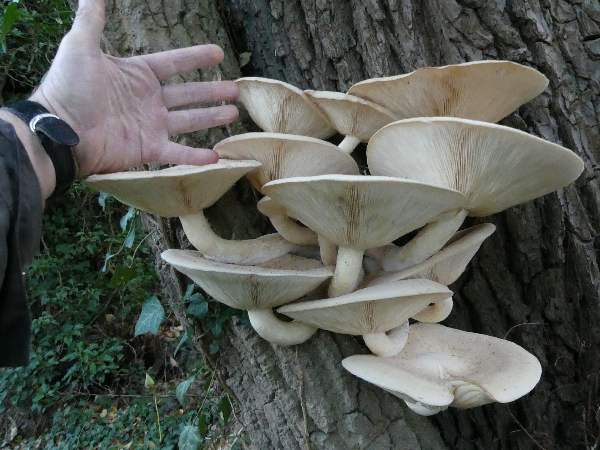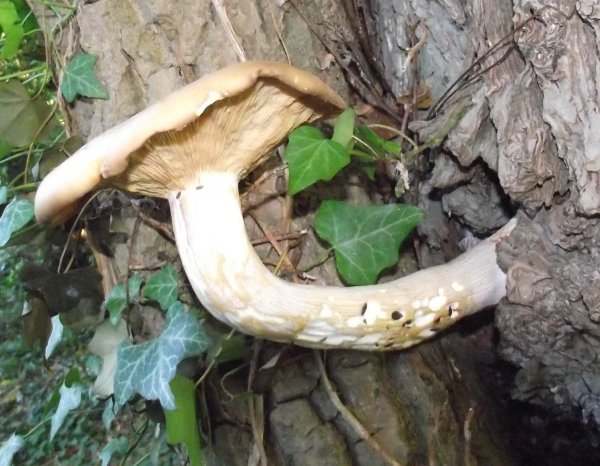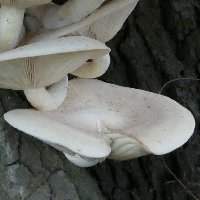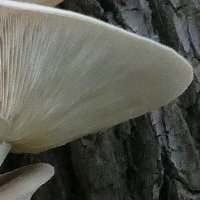Hypsizygus ulmarius (Bull.) Redhead - Elm Oyster
Phylum: Basidiomycota - Class: Agaricomycetes - Order: Agaricales - Family: Lyophyllaceae
Distribution - Taxonomic History - Etymology - Identification - Culinary Notes - Reference Sources

The Elm Oyster fruits high up on the trunks and large branches of elm trees (Ulmus spp.) and occasionally other broadleaf deciduous trees. Often the fruitbodies form compact clusters with their stem bases emerging from a single branch scar, and so the stems are nearly always bent rather than straight.

Distribution
A widespreadbut rather uncommon find in Britain and Ireland, the Elm Oyster occurs also throughout most of northern mainland Europe as well as in other temperate parts of the world including North America.
Taxonomic history
This impressive fungus was first described in scientific literature in 1791 by pioneering French mycologist Jean Baptiste Francois Pierre Bulliard, who gave it the scientific name Agaricus ulmarius. (In the early days of fungal taxonomy most of the gilled mushrooms were included initially in the genus Agaricus, the contents of which has since been largely dispersed into many other newer genera.) The currently-accepted scientific name Hypsizygus ulmarius dates from a 1984 publication by Canadian mycologist Scott Redhead.
Synonyms of Hypsizygus ulmarius include Agaricus ulmarius Bull., Pleurotus ulmarius (Bull.) P. Kumm., Tricholoma ulmarium (Bull.) P. Karst., and Lyophyllum ulmarium (Bull.) Kühner.
Etymology
Hypsizygus, the genus name, comes from Hypsi- meaning 'high up' and -zygus meaning a 'yoke'; it reflects the fact that the fruitbodies usually occur high up on the trunks of large trees. The specific epithet ulmarius means 'of elm trees'.
Identification guide
 |
CapUsually 6 to 15 (exceptionally up to 30) cm across; convex, expanding but retaining and incurved margin; white; smooth and dry. |
 |
GillsAdnate or only very slightly decurrent; broad, crowded; white. Stem6 to 13cm long and 2 to 3cm dia.; white; smooth or finely fibrillose; no stem ring. |
SporesBroadly sublobose, smooth, 3.5-6.5 x 3-5µm, inamyloid. Spore printWhite to pale cream.. |
|
Odour/taste |
Odour insignificant or sometimes slightly mealy; taste mild but not distinctive. |
Habitat & Ecological role |
Parasitic or saprophytic, causing white rot on damaged parts of hardwood trees, particularly standing elms (Ulmus spp.). |
Season |
Summer, autumn and early winter in Britain and Ireland. |
Similar species |
The Elm Oyster could be confused with mushrooms of the Pleurotus genus, for example Branched Oyster Mushroom Pleurotus cornucopiae, which has deeply decurrent gills. |
Culinary notes
Although reported by some authorities as edible, the relative scarcity of Elm Oysters and the fact that they usually grow high up on trees (*and therefore out of easy reach) makes them of little interest to those who gather wild mushrooms to eat. Home cultivation kits are readily available, however, in the form of impregnated logs, or impregnated plugs that can be inserted into holes drilled in elm or beech logs.
Reference Sources
Fascinated by Fungi, 2nd Edition, Pat O'Reilly 2016, reprinted by Coch-y-bonddu Books in 2022.
British Mycological Society, English Names for Fungi
Dictionary of the Fungi; Paul M. Kirk, Paul F. Cannon, David W. Minter and J. A. Stalpers; CABI, 2008
Taxonomic history and synonym information on these pages is drawn from many sources but in particular from the British Mycological Society's GB Checklist of Fungi.
Acknowledgement
This page includes pictures kindly contributed by Richard Shotbolt.
Fascinated by Fungi. Back by popular demand, Pat O'Reilly's best-selling 450-page hardback book is available now. The latest second edition was republished with a sparkling new cover design in September 2022 by Coch-y-Bonddu Books. Full details and copies are available from the publisher's online bookshop...

